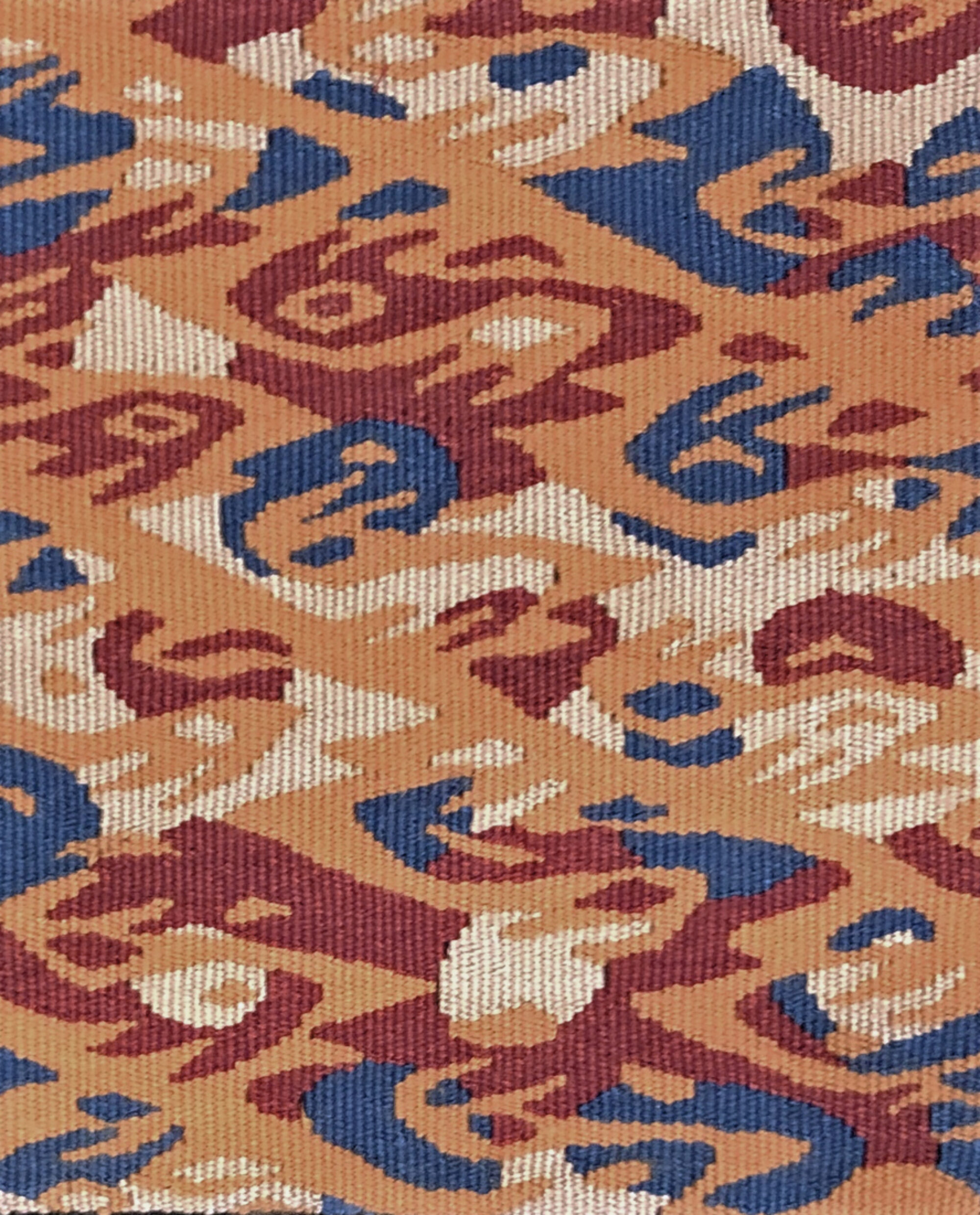This article was first published in the American Tapestry Alliance’s newsletter Tapestry Topics, Vol. 40, No. 4.
Coptic tapestry has long been admired for its colorful and engaging imagery. It has provided inspiration not only for weavers, but also for painters such as Henri Matisse, who was fascinated by the newly amassed Egyptian collections arriving in France during the late nineteenth and early twentieth centuries.1
The term Coptic is derived from a Greek word meaning Egyptian. The Arabs, who conquered Egypt in AD 640, also used Coptic to refer to native Egyptians, who for many years had been subjected to the rule of outside cultures and, at the time of the Arab conquest, were primarily Christian. The term Coptic is still used to refer to the Christian minority in Egypt. The Coptic period in Egypt begins in the late 3rd C AD, under the influence of late Roman art and continues to develop during the Byzantine Period.2 Its efflorescence coincides with the integration of Christianity into Egyptian society. After the Arab conquest, evidence of Coptic culture is restricted to Christian features of Islamic art.
Coptic textiles date from the late Roman period to Islamic times. They include garments, hangings, cushion covers and other household decorations. Earlier burials from the Dynastic Period in Egypt contain textiles such as mummy wrappings or grave goods, but textile remains are considerably more numerous after the dynastic practice of mummification was abandoned in the 4th C AD. After that people were buried fully clothed with additional textiles wrapping the body.3 The large quantity of ancient textiles preserved in Egypt is also a gift of the arid climate, which is favorable to preservation.
Among the vast repertoire of Coptic textiles, tapestries exist primarily as fragments. Many of these tapestry fragments originally adorned plain-woven linen tunics and some of them were shaped tapestries. Tunics, like other Coptic fabrics, are woven in both rep and tapestry weave. A linen ground cloth is combined with tapestry ornaments in the shape of bands, squares, ovals and roundels. The transition from plain weave to tapestry weave was handled in several ways. The warp might be doubled or trebled in the tapestry areas or some of the warps might be skipped and allowed to hang on the back as floats, or cut off after the textile was finished.4
The Coptic people adopted the tunic from the Romans, who conquered Egypt in 30 BC. Straight sided, loose fitting gowns or long shirts, tunics were often worn in layers, the outermost being decorated with the colorful, tapestry inserts. Because the tapestry woven areas were more time consuming to weave, the width of the bands and the extent of additional decorative ornaments reflected the value of the cloth and the wealth and rank of the wearer.5
Tapestry panels on tunics usually consist of a pair of purple, longitudinal bands running from the shoulder down the front and back. The long narrow bands, called clavus bands, or clavi, are either unpatterned or a combination of purple wool surrounded by linen.6 Additional tapestry embellishments on tunics include: orbiculae (round or oval ornaments) or other shaped ends to the clavi; tabulae (squares) placed at the shoulders, sleeves or hem; and transverse bands at the neckline between the clavi and the sleeve.
Several factors trouble the dating of Coptic tapestries. Most of the textiles were collected before the practices of archaeology became systematized and consequently are not accompanied by information such as provenance, stratigrahpic dating or other contextual records. In addition, grave looters looking for more precious materials often discarded textiles, separating them from other artifacts, such as coins, which are more easily dated. Because textiles were often cut into pieces and sold to several museums, understanding even the form and format of Egyptian textiles is difficult.
Although wall paintings, mosaics, book illuminations and written sources give important information about textiles and textile production that help date pieces, style has been the principal dating criterion. Stylistic dating, however, is problematic due to several factors. Primary among them is the persistence of the earlier classical style during the later development of a more abstract mode. These two styles occur at different times and places in many variants and intermixtures. Several other factors confuse stylistic dating, including: the variable ability of weavers to replicate the models that served as source material for the images; the slower dissemination rate of stylistic changes to provincial workshops operating at a distance from the source of the style; and the development of regional styles, which operated independently of the dominant production centers. Some of the textiles found in Egypt may also be of foreign manufacture. These factors, while complicating dating, result in a richly diverse corpus of Coptic textiles.
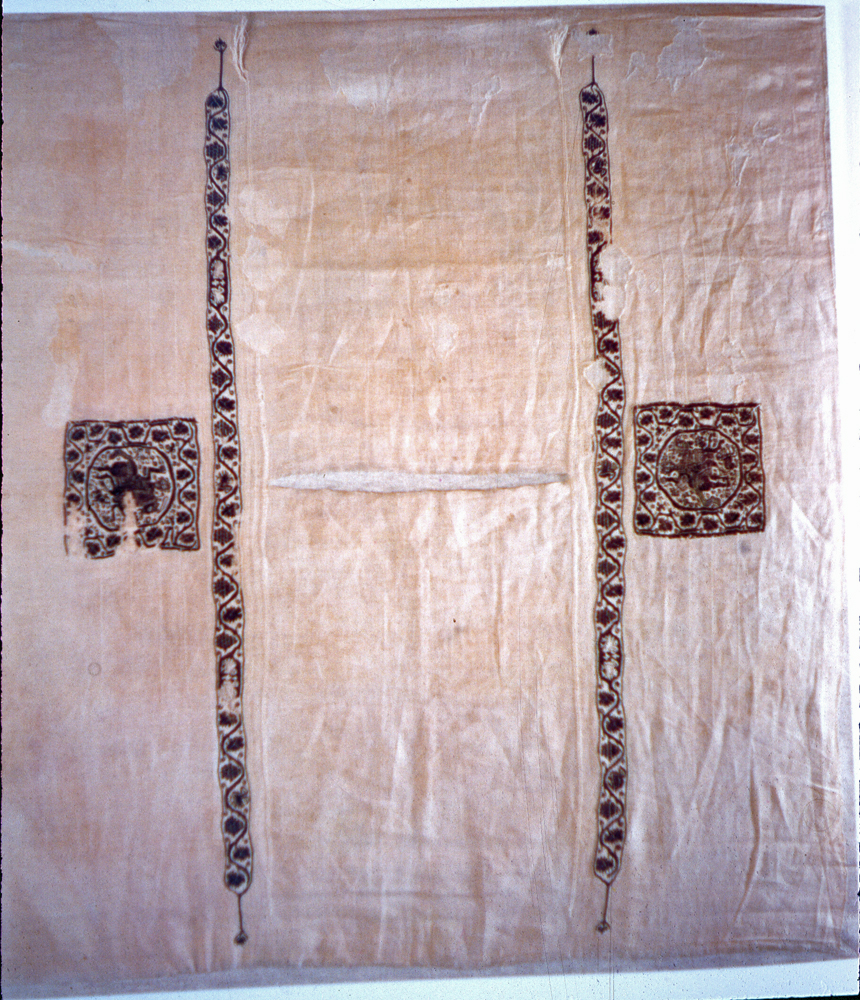
Tunic with cavaliers is a typical example of a 7th C Coptic tunic. The longitudinal clavi terminate in palmettes and are framed by two tapestry squares at the shoulder. A slit provides the opening for the neck. The ornaments on tunics were often placed at the shoulders and knees, two vulnerable joints subject to disease and crippling. The placement of the decoration may have been apotropaic, warding off the evil eye. Defense against the evil eye was typically: an eye that stared back with a power that counteracted the evil force; an upraised hand; or a design that was so complex or fascinating, e.g. an interlace pattern, that it captured the stare of the evil eye and kept it moving.7
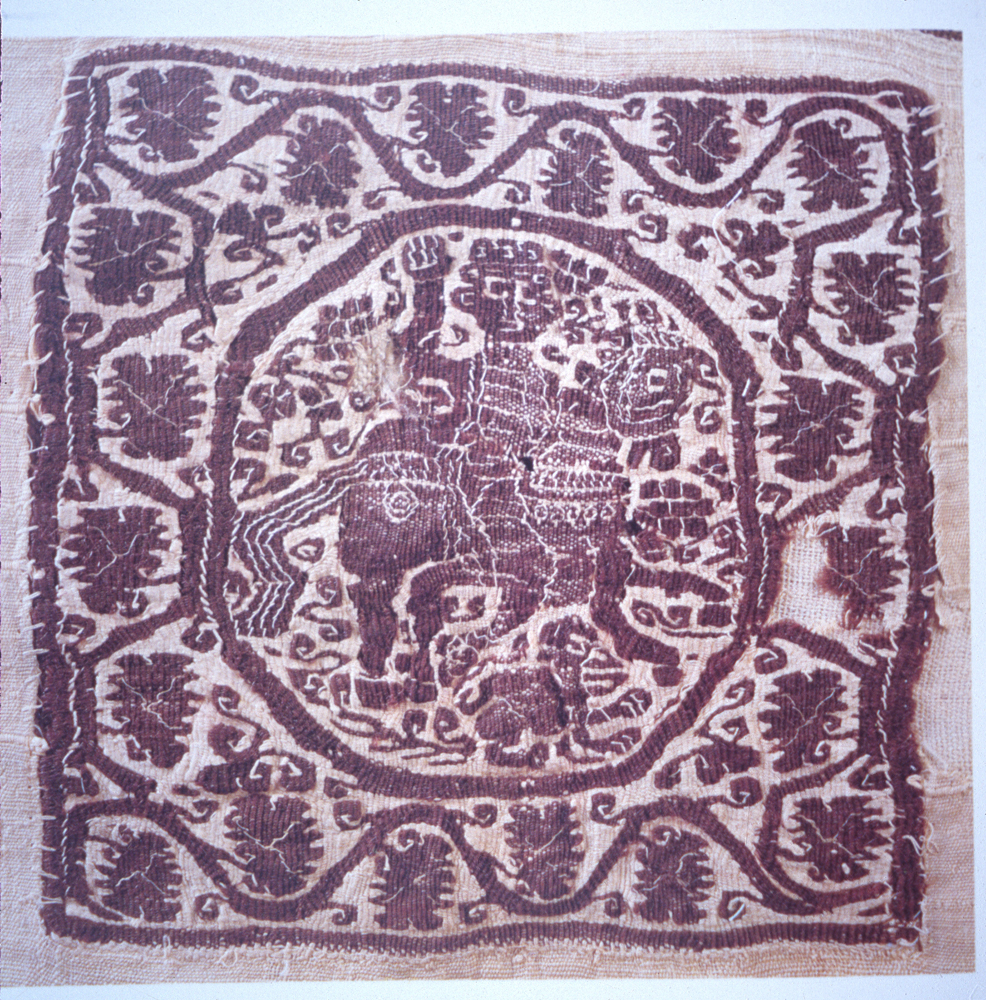
In this monochromatic tunic the clavi bands are ornamented with grape clusters. The grape harvest is associated with Dionysus and with funerary practices, the harvesting of grapes being symbolic for the harvesting of lives. The flanking squares show a mounted rider with his hand raised. This image combines the apotropaic, protective function of the raised hand with the mounted rider who came to symbolize the Christian victory of life over death. The rider with his raised hand is also reminiscent of Christian orant figures.8
Christian saints are often depicted astride horses. The mounted horseman also figures in mythological battles between good and evil. Mounted saints may have their source in Thracian votive or funeral stele, in Greek and Roman equestrian statues or in the hunting scenes found in Roman mosaics and sarcophagi. Imperial Roman representations give way to two iconographical types of cavalier saints, the armed fighting horseman who evokes the militant triumph of Christianity over paganism and the static horseman, surrounded by a halo of his martyrdom or apostate.9
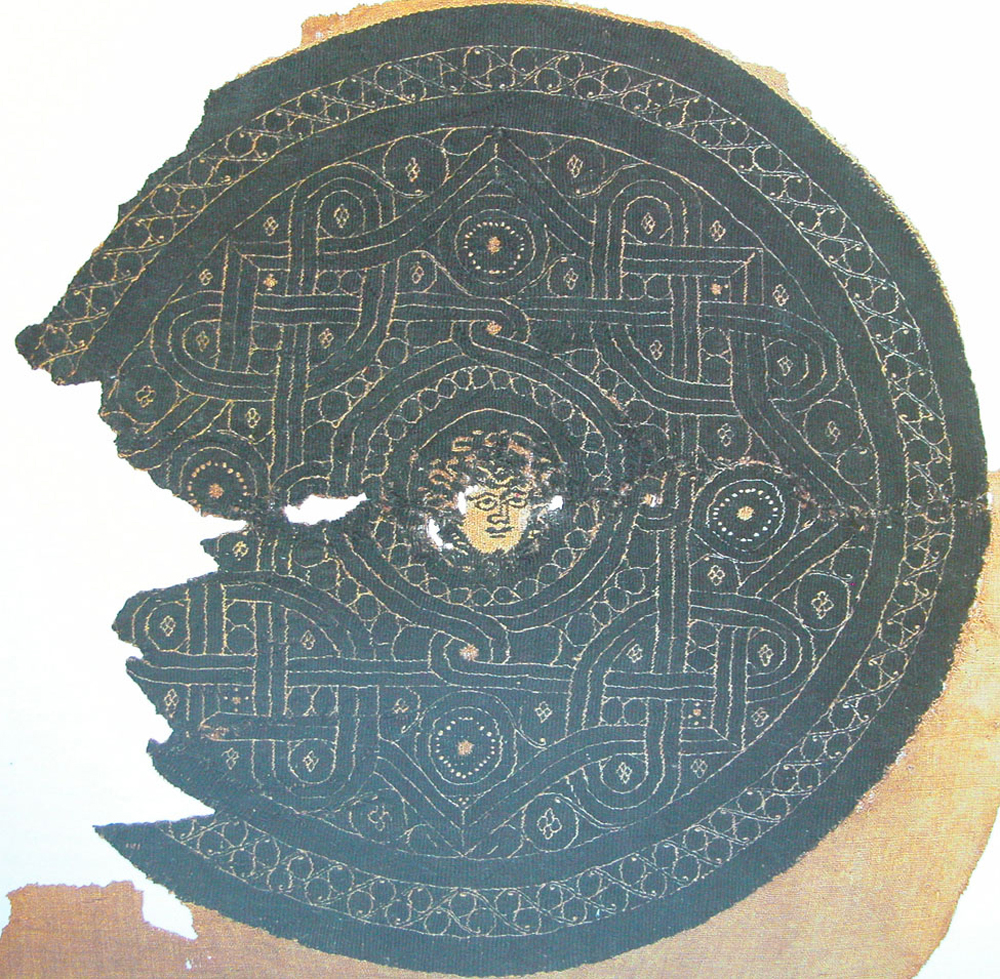
Monochrome tapestries, such as Tunic with cavaliers, rely on line and silhouette for their effect, a design sensibility also present in painted Greek vases. The most successful achieve a sense of balance and clarity amidst their detail. In this piece the image is defined not only by the combination of the purple tapestry weave and the background linen, but also by the technique referred to as flying shuttle, in which the lighter linen thread is allowed to float across the surface of the fabric in order to create finer, vertical lines. This is especially apparent in the figure and the horse. Flying shuttle is developed to a much greater extent in the monochrome geometric and interlace patterns common in tapestry inserts such as Tunic roundel with a human face.
Tapestry inserts can also be multicolored. Polychrome tapestries may be realistic, with hatching and other illusionist devices, or they may eschew realism, using large areas of bold color, conventionalized detail, or both. Three examples will display the variety present as cultural changes produced a shift from realism to abstraction.
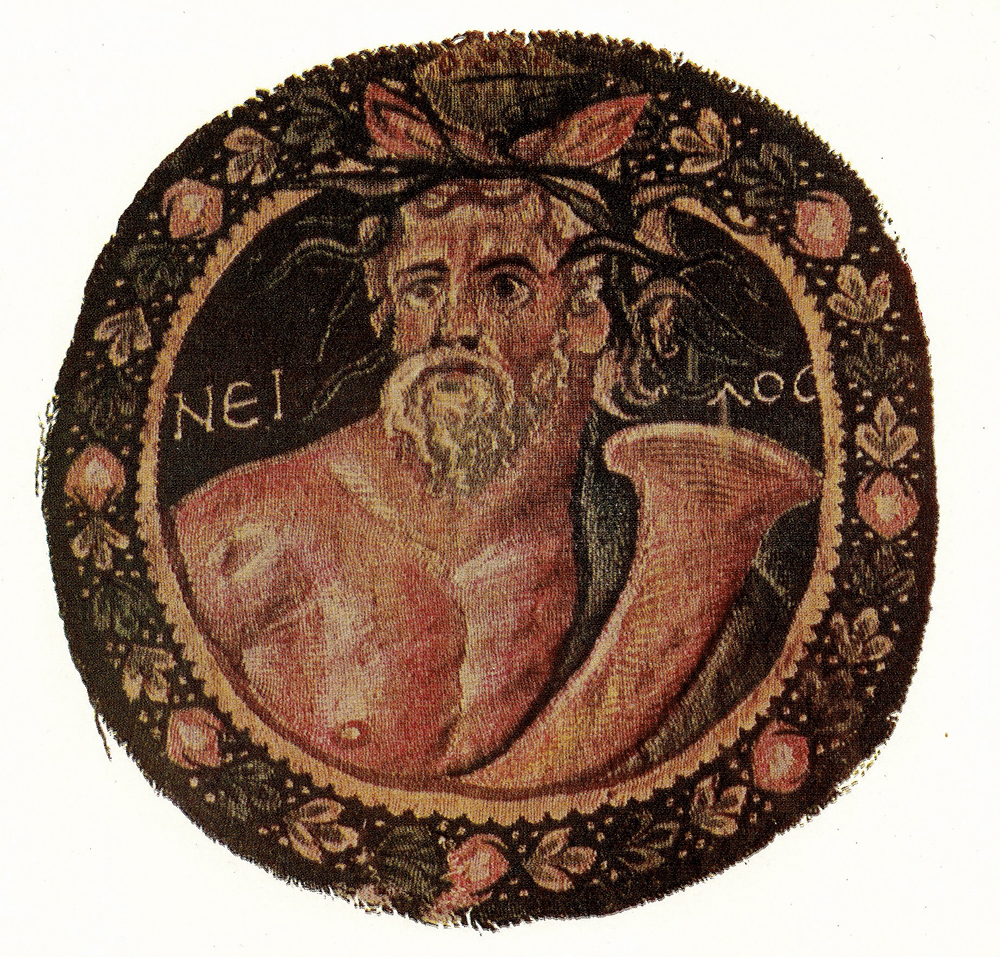
The Orbiculus with the head of the Nile god, dated between the 3rd and 4th Centuries exemplifies the fusion that took place between the Nilotic imagery of Dynastic Egypt and the classical realism of the Greek and Roman cultures. The figure in the tapestry is the personification of the ancient Egyptian god of the Nile River. His hair contains riparian flora and he holds the symbol of the river’s plenty and fertility, the cornucopia. The style of the figure, however, is classical, influenced by the style of late Roman portraiture. Within the body and the drapery, hatching with several values of a flesh tone creates an illusionistic, three-dimensional representation of the figure. The finely rendered features of the face and beard enhance the individualism of the figure. The Nile god is shown glancing over his shoulder, as though caught at a specific moment in time. The decorative, circular border contains flowers and fruit, the bounty of the Nile.
The persistence of pagan motifs both by themselves and in a newly Christianized context points to the complexity of the religious climate during this period. Their coexistence reflects both the cultural changes taking place and the underlying similarities between the two belief systems. For example, Christianity and paganism are both built upon dualisms – of order and disorder, civilization and barbarism, of the spiritual and the natural. These dualisms were symbolized by battles between men and animals, between men and mythical beasts or by pairs of identical humans.10 The structural similarities allowed for the incorporation of elements of the older, indigenous belief system into Christianity, thus easing the transition.
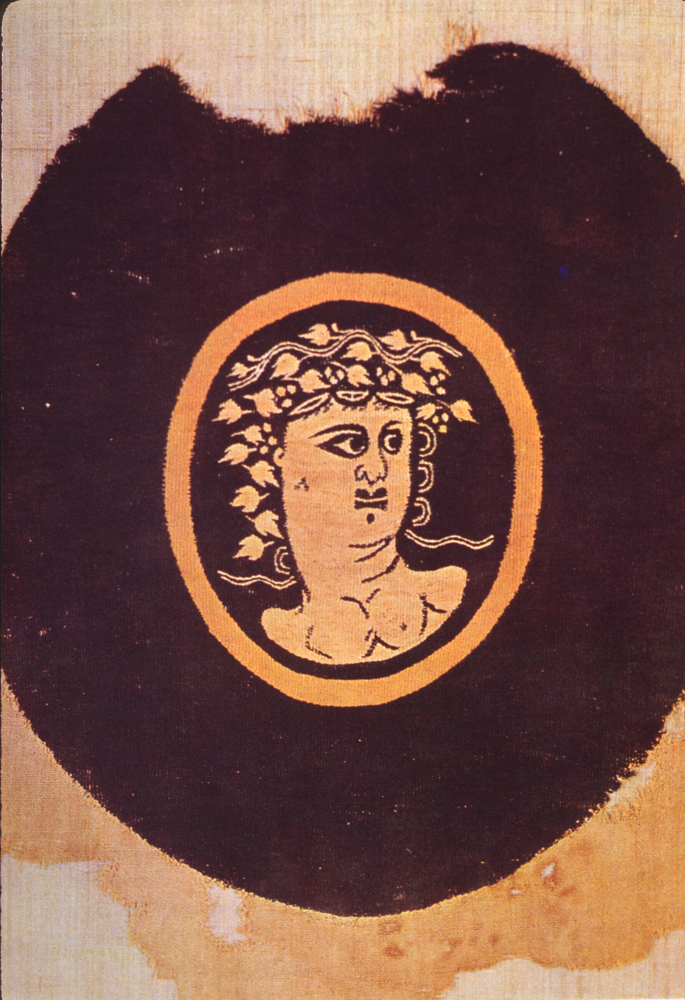
Around 450 – 500 AD the shift to the Byzantine style becomes apparent. The Head of Dionysus no longer displays the same interest in realism seen in the representation of the Nile River god. The Greek god, Dionysus, often shown with his head wrapped in a garland of grape vines, replaced Osiris, the Egyptian god of the dead, resurrection, and master of wine. Dionysus’ connection to sacrifice and rebirth allowed for his subsequent assimilation into Christian iconography.11 Although Dionysus is shown in three quarters view, this image does not express the individualism seen in the portrait of the Nile River god. The Byzantine style favors absolutism and ceremony and is marked by abstraction and otherworldliness. The forms are simplified and the anatomy is less precise. The stylized features in this tapestry include enlarged eyes with thick outlines, a broad caricatured mouth and distortion in the proportions of the body. The interaction between the foreground and the background also plays a much greater role in the image.
Changes in style from more realistic to less realistic do not necessarily imply a loss of technical skill. More commonly they reflect cultural changes. The prevalent imagery and style of a particular time period reflects the current cultural ideology. The stylistic changes seen in the representations of the Nile River god and Dionysus mirror the shift from a more humanistic, pagan culture to the other worldly focus of the Christian Byzantine period in which the individuality of the person and the specificities of life on earth were of less importance.
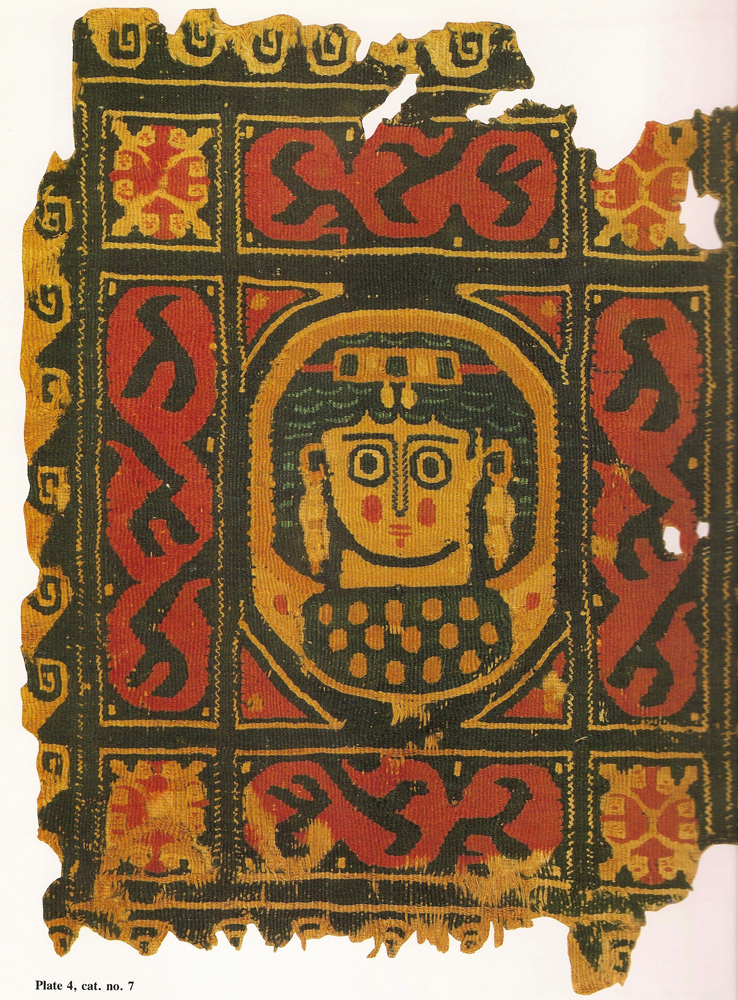
The extremely conventionalized approach to representation that developed during the later Byzantine period is apparent in the Rectangular panel with a bust of a woman, dated to the 5th C or later. The frontal, static portrait employs a geometric approach to form in which the facial features and structural anatomy are reduced to heavy lines and circles, the jewelry to a line of squares and the hair to a repeating arc. This style, which focuses more on composition and design than on realism, emphasizes not the individuality, humanity and vitality of human beings, but rather the timeless and spiritual nature of life. The bust is surrounded by equally stylized vine motifs and squares containing flowers.
The stylistic variety exhibited in this small selection of Coptic tapestries reflects the influences of the various cultures that ruled Egypt. From the incorporation of new deities and spiritual faiths, to the assimilation of stylistic devices, these transformations mark the interchange between two cultures. In the case of Coptic art, this interchange did not involve a wholesale adoption of each succeeding ruling culture’s artistic mode, but rather a complex and unique blending of elements from Dynastic, Greek, Roman and Islamic art. The lively intermixture of motifs, the strong colors and the technical weaving skills combine to produce a vital and compelling art form that continues to delight viewers.
End Notes
[1] Hoskins, Nancy Arthur. The Coptic Tapestry Albums & the Archaeologist of Antinoé, Albert Gayet. Seattle: University of Washington Press, 2004, 9-10.
[2] Until 332 BC Egypt was ruled by a succession of Pharaonic dynasties. A simplified chronology of the cultures who subsequently invaded and ruled Egypt is as follows: Ptolemaic (Greek) Period, 332 – 30 BC. Roman Period, 30 BC – AD 395. Byzantine Period, AD 395 – 611. Persian Period, AD 611 – 639. Islamic Period, AD 640 – present
[3] Most of the excavated textiles show signs of wear, indicating that they were not made specifically for burials. Thompson, Deborah. Coptic Textiles in the Brooklyn Museum. New York: The Brooklyn Museum, 1971, 1.
[4] Hoskins, Nancy Arthur. The Coptic Tapestry Albums & the Archaeologist of Antinoé, Albert Gayet. Seattle: University of Washington Press, 2004, 43-44.
[5] Although the form of the tunic remains fairly consistent through time, the mode of construction changes. Early tunics were woven as one piece of fabric – starting with one sleeve, proceeding through the body and finishing with the other sleeve. This layout requires a loom almost three meters wide. Eventually (maybe in the 4th or 5h C), the tunic sleeves were woven separately and sewn onto the body of the tunic, which was still woven from side to side with a slit opening for the neck. By the middle of the 5th C, the tunic was constructed as a square folded in half and sewn up the edge with the sleeves attached. The loom width required for this is only half that of the poncho style construction. Other modifications in the tunic design include weaving the ornaments separately and sewing them on the tunic, an earlier practice employed to reuse the tapestry sections from worn garments. Weaving the tapestry sections separately would have also allowed for specialization among the weavers. Carroll, Diane Lee. Looms and Textiles of the Copts: Memoirs of the California Academy of Sciences, Number 11. Seattle: University of Washington Press, 1986, 40-41.
[6] Since the cost of the tunics was based on the weight of the dyed yarn, a combination of wool and linen would have extended the more costly dyed woolen threads over a greater area.
[7] Carroll, Diane Lee. Looms and Textiles of the Copts: Memoirs of the California Academy of Sciences, Number 11. Seattle: University of Washington Press, 1986, 54.
[8] The Christian orant, or praying figure, fulfills the same function, since it is through praying that a Christian accesses the power of God.
[9] The horse was introduced into Pharaonic Egypt in the 17th C BC but the pharaoh and high-ranking dignitaries usually rode in horse drawn chariots. The first image of a king on horseback comes in the Ptolemaic period. The only mounted divinity in the Nile Valley is Astante, of Oriental origin, who was adopted by the Egyptians as the mistress of the horse and chariot. The cavalier saints may hold the crown of victory, or be fighting an animal, trampling a snake or thrusting a spear into a snake’s mouth. Rutschowscaya, Marie Helene. Coptic Fabrics. Paris: Editions Adam Biro, 1990, 137-140.
[10] Carroll, Diane Lee. Looms and Textiles of the Copts: Memoirs of the California Academy of Sciences, Number 11. Seattle: University of Washington Press, 1986, 65.
[11] Rutschowscaya, Marie Helene. Coptic Fabrics. Paris: Editions Adam Biro, 1990, 82.
References
Carroll, Diane Lee. Looms and Textiles of the Copts: Memoirs of the California Academy of Sciences, Number 11. Seattle: University of Washington Press, 1986.
Hoskins, Nancy Arthur. The Coptic Tapestry Albums & the Archaeologist of Antinoé, Albert Gayet. Seattle: University of Washington Press, 2004.
Kybalova, Lumila. Coptic Textiles. London: Paul Hamlyn, 1967.
Rutschowscaya, Marie Helene. Coptic Fabrics. Paris: Editions Adam Biro, 1990.
Stauffer, Annemarie. Textiles of Late Antiquity. New York: The Metropolitan Museum of Art, 1995.
Thompson, Deborah. Coptic Textiles in the Brooklyn Museum. New York: The Brooklyn Museum, 1971.
Trilling, James. The Roman Heritage: Textiles from Egypt and the Eastern Mediterranean, 300 to 600 AD. Washington D.C.: The Textile Museum, 1982.
Volbach, W. Fritz. Early Decorative Fabrics. London: Paul Hamlyn, 1969.
